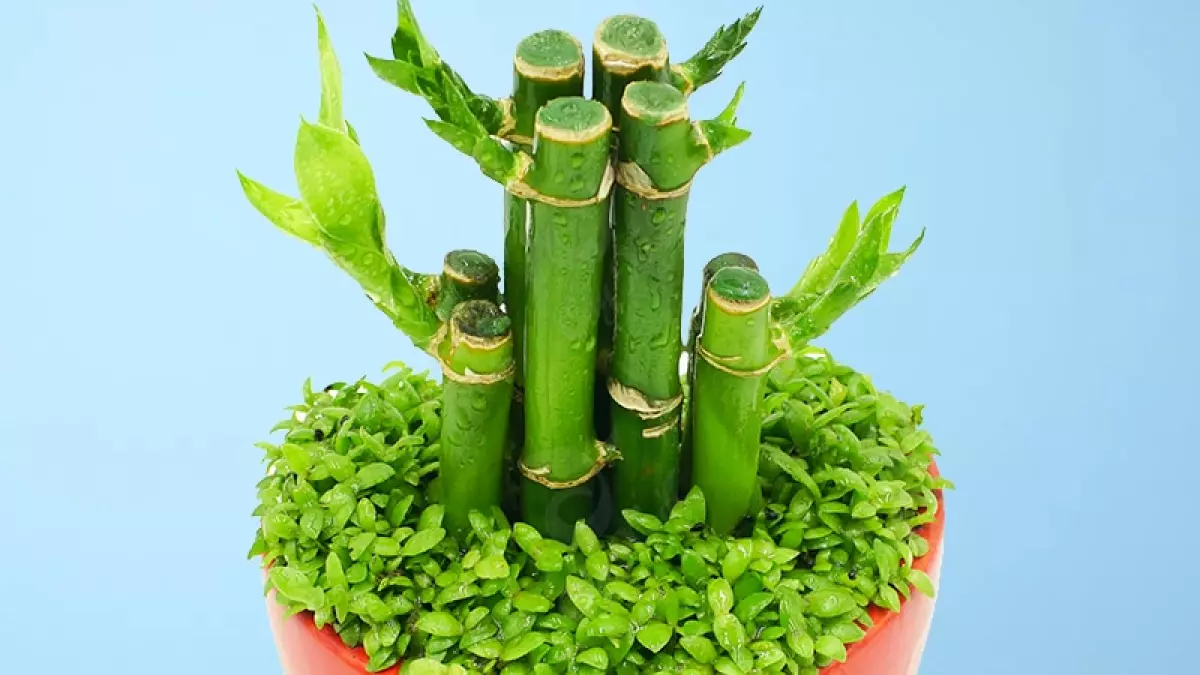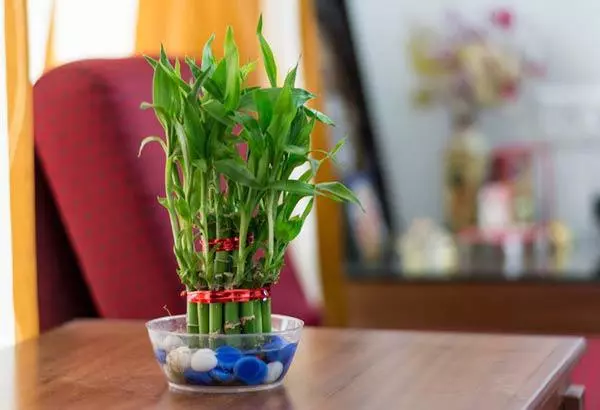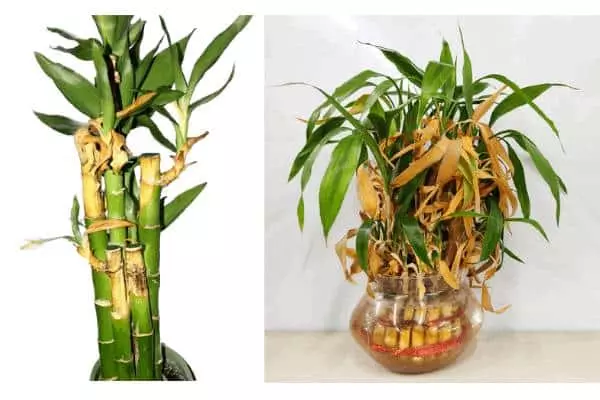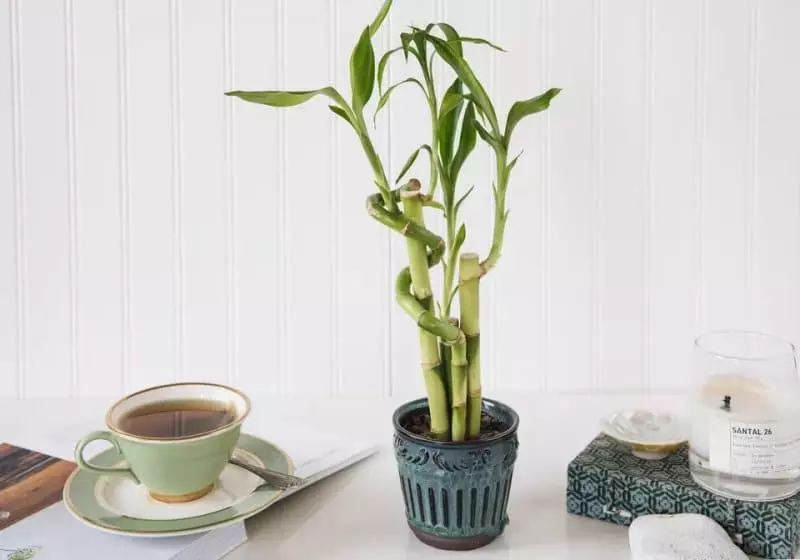Have you ever wondered about the mystique surrounding lucky bamboo? Contrary to popular belief, lucky bamboo is not bamboo at all! Its scientific name is Dracaena sanderiana, and it belongs to the Asparagaceae family. Native to the lush tropical forests of Central Africa, lucky bamboo thrives under the dappled sunlight that filters through the canopy of trees.
With its slender, straight stems, lucky bamboo can grow to varying heights, ranging from a few inches to several feet. The stems are a delightful shade of green, often adorned with delicate vertical stripes that add texture. As the plant matures, the stems become thicker and stronger.
The vibrant green leaves of lucky bamboo are elongated and lance-shaped, typically clustered at the top of the stems, creating a lush and full appearance. Occasionally, the leaves may exhibit a slightly yellowish-green hue, indicating excessive sun exposure or poor water quality.
One of the most appealing qualities of lucky bamboo is its versatility in being trained into various shapes and forms. With patience and skill, these plants can be gracefully shaped into spirals, braids, hearts, and even intricate multi-tiered designs. This adaptability has made lucky bamboo a popular choice among plant enthusiasts and feng shui practitioners alike.
In the realm of Feng Shui, lucky bamboo is sought after to balance the flow of energy, attract positive vibrations, and dispel negative energies. It is commonly used as a decorative element in homes, offices, and businesses, symbolizing good luck and bringing a sense of harmony.
Unlocking the Meaning of Lucky Bamboo in Feng Shui
 Lucky bamboo is often referred to as the lucky plant in the Feng Shui community.
Lucky bamboo is often referred to as the lucky plant in the Feng Shui community.
For centuries, lucky bamboo has been revered in the world of Feng Shui. In our Feng Shui community, we often refer to it as the "lucky plant." Its symbolic significance has been harnessed in numerous projects aimed at creating good Feng Shui for clients.
Lucky bamboo represents prosperity, good fortune, and positive energy. In fact, there is a Chinese saying that goes, "If you want to invite good luck into your life, welcome a lucky bamboo plant into your home."
Different styles of lucky bamboo stalks hold various meanings in Feng Shui. For example, two stalks represent love and doubled luck, while five stalks attract wealth and happiness. If you're aiming for an abundance of good luck, opt for a plant with nine stalks—the pinnacle of luck symbolizing overall fortune and the fulfillment of desires. In Chinese culture, the number nine signifies eternity and longevity.
Harnessing the Power of Lucky Bamboo to Attract Wealth and Luck
 Place a pot of lucky bamboo in a wealthy corner or near the entrance door to attract wealth into your home.
Place a pot of lucky bamboo in a wealthy corner or near the entrance door to attract wealth into your home.
Now that you grasp the essence of lucky bamboo, let's dive into how you can utilize it to attract luck and wealth into your home. In Feng Shui, every number carries a special significance. To invite wealth, select a lucky bamboo plant with three, five, or nine stalks. The number five holds particular allure as it represents the five elements of Feng Shui—wood, fire, earth, metal, and water. These elements harmoniously balance the energy, paving the way for prosperity.
To maximize its wealth-attracting potential, place your lucky bamboo plant in the southeastern corner of your home or workspace—the "wealth corner" in Feng Shui. From the perspective of the front door, this corner is located on the far left. Known as "Xun" in Chinese, it sparks inspiration for financial gain. You can also position lucky bamboo near your entrance door or on your desk, adhering to Feng Shui principles.
Remember that indirect sunlight and fresh water are vital for the growth of your lucky bamboo. To enhance its power further, you can adorn the stem with a red ribbon or place it in a red-colored box. Red, a powerful color in Feng Shui, symbolizes prosperity and luck while adding a vibrant touch to any space. Additionally, visualize your desired wealth and abundance as you place the lucky bamboo, letting your intentions manifest through this remarkable plant.
Nurturing Lucky Bamboo: Indoor Care Tips

Lucky bamboo not only pleases the eye but is also effortless to care for. However, a few considerations will ensure its optimal growth. Direct sunlight is a no-go; it can scorch the leaves. Instead, position your plant where it can bask in indirect sunlight. A north or east-facing windowsill is ideal for maintaining its well-being.
When it comes to watering lucky bamboo, it's a bit particular. Opt for filtered or distilled water, as tap water may contain chemicals and minerals that are harsh on the plant. Change the water every week to keep it fresh and clean, enabling your lucky bamboo to grow healthy and robust.
The water level should be just above the roots, around one or two inches. If you prefer growing lucky bamboo in soil, keep the soil moist but not waterlogged, as waterlogging is detrimental to any indoor plant.
Lucky bamboo thrives in a warm environment, with temperatures ranging from 65-95°F (18-35°C). Avoid placing your plant near drafts, vents, or heaters to prevent temperature fluctuations that could distress it.
To nourish your lucky bamboo, use a balanced indoor plant liquid fertilizer diluted to half strength. Feed your plant every few months, and it will reward you with vibrant green leaves and vigorous growth.
Troubleshooting Common Lucky Bamboo Issues
 Yellowing leaves are a common issue with lucky bamboo plants when grown indoors.
Yellowing leaves are a common issue with lucky bamboo plants when grown indoors.
Although lucky bamboo is easy to grow and care for, it may encounter a few health issues, much like any other plant.
-
Yellow leaves: Yellowing leaves can be caused by excessive sunlight, over-fertilization, or poor water quality. Protect your plant from direct light, reduce fertilizer use, and switch to filtered or distilled water to restore its luscious green color.
-
Soft, mushy stalks: Overwatering or root rot could be the culprits behind soft, mushy stalks. If you're growing lucky bamboo in water, change it more frequently and ensure the cleanliness of the roots. For soil-grown plants, allow the soil to dry slightly between waterings to avoid waterlogged roots.
-
Brown tips: Dry air or underwatering can result in brown tips. Increase humidity around your plant with a humidifier or pebble tray if your indoor air is arid. Remember to keep the roots submerged in water or the soil consistently moist.
-
Leaf drop: Leaf shedding may occur due to temperature fluctuations or drafty conditions. Provide your plant a stable environment, away from drafts, air vents, and heaters.
-
Pests: While lucky bamboo is generally resistant to pests, occasional intruders like spider mites, mealybugs, or aphids may appear. Treat your plant with insecticidal soap or neem oil to eliminate these unwelcome visitors.
-
Slow growth: If your lucky bamboo seems to be in slow motion, ensure it receives sufficient indirect light. Consider providing a balanced liquid houseplant fertilizer (diluted to half strength) every few months to promote growth.
Referencing reliable sources like FiddleandThorn, we have highlighted common issues that lucky bamboo may face. Stay vigilant and address these problems promptly to nurture a thriving and auspicious plant that brings luck and positive energy to your environment.
The Bountiful Benefits of Having Lucky Bamboo at Home
 The benefits of lucky bamboo are bringing good luck and purifying the air inside the house.
The benefits of lucky bamboo are bringing good luck and purifying the air inside the house.
As the name "lucky plant" suggests, lucky bamboo offers a multitude of benefits when grown indoors. Let's uncover some remarkable advantages that lucky bamboo brings to your space:
-
Aesthetically pleasing: Lucky bamboo's graceful, slender stalks and lush green leaves add a touch of beauty to any space. The various shapes and arrangements, from spirals to braids, infuse an artistic flair into your home.
-
Low maintenance: Lucky bamboo is a plant that demands little effort to care for, making it an ideal choice for busy individuals or novice plant enthusiasts. Provide it with indirect light, clean water, and a little affection, and it will thrive.
-
Air purifier: Surprisingly, lucky bamboo serves as a natural air purifier, removing toxins like formaldehyde, benzene, and trichloroethylene from the air, creating a fresher and healthier indoor environment.
-
Good luck charm: Beyond its decorative value, lucky bamboo is renowned for attracting good fortune, happiness, and prosperity. Regardless of your beliefs, having a symbol of positivity and luck in your home can only enhance your environment.
-
Stress reducer: Studies have shown that having plants in your living space reduces stress and promotes a sense of well-being. Embrace the Zen brought by lucky bamboo in your life.
-
Feng Shui booster: In the realm of Feng Shui, lucky bamboo symbolizes positive energy, growth, and balance. Placing it strategically in your home amplifies the flow of good vibes, fostering a harmonious atmosphere.
Lucky bamboo is not only a delight for plant enthusiasts but also an auspicious addition for those seeking to improve their financial well-being. This versatile and charming plant not only enhances the beauty and style of your space but also brings health, happiness, and good fortune in abundance.
Styles of Lucky Bamboo for Every Taste
 There are many different styles of lucky bamboo for you to choose from.
There are many different styles of lucky bamboo for you to choose from.
As a Feng Shui expert, I can't help but admire the artistry and creativity in shaping these remarkable plants. Lucky bamboo offers an array of styles to suit every preference and purpose. Here are a few notable styles:
-
Straight stalks: The classic style involves straight stalks of lucky bamboo arranged in groups, each representing different aspects of life, such as love, health, or wealth. It's a timeless, elegant choice.
-
Spiral stalks: These visually captivating stalks are meticulously shaped into spirals by rotating the plant towards sunlight over time. The spiral signifies growth and positive energy, making it perfect for any Feng Shui-friendly environment.
-
Heart-shaped: A symbol of love, heart-shaped lucky bamboo stalks exude affection and harmony. They make a thoughtful gift for a loved one or a beautiful expression of self-love.
-
Braided: In this style, multiple stalks of lucky bamboo are skillfully woven together in a braid-like pattern. The braid represents strength and unity, fostering a sense of togetherness and support in your home.
-
Multi-tiered: Ascending tiers of stalks, resembling miniature pagodas, create a multi-tiered style. The tiered arrangement symbolizes growth and progress, inspiring you to reach new heights both personally and professionally.
-
Combination: Why limit yourself to a single style when you can combine multiple ones? Many lucky bamboo arrangements feature a blend of spiral, braided, and other styles, allowing for endless creativity and eye-catching displays.
Frequently Asked Questions (FAQs)
Can lucky bamboo be grown in water?
Absolutely! Lucky bamboo is one of the few plants that thrive in both water and soil. Here's a simple guide on growing lucky bamboo in water:
-
Find a beautiful container, such as a glass vase or jar, that can hold about 1-2 inches of water and provides ample space for the roots to grow.
-
Fill the container with clean, filtered, or distilled water. Tap water can be harsh due to chemicals and minerals.
-
Gently place your lucky bamboo into the container, ensuring that the roots are submerged. Use pebbles or small rocks for additional support if needed.
-
Change the water weekly to maintain freshness and prevent the buildup of algae or harmful bacteria. Every few months, add a diluted dose of liquid indoor plant fertilizer to keep your lucky bamboo healthy.
How to propagate lucky bamboo?
Propagating lucky bamboo is a straightforward process. Let's go through it step by step:
-
Choose a healthy parent plant with green leaves and a robust appearance.
-
Using sharp and clean pruning shears or a knife, cut a healthy offshoot above a leaf joint (node) at a 45-degree angle. This encourages new growth on the parent plant.
-
Trim the leaves on the lower part of the cutting, leaving a few at the top to divert energy towards root development.
-
Allow the cut end to heal and form a callus by placing the cutting in a cool, dry spot for a day or two. This prevents rot when planting in water or soil.
-
Root the cutting either in water or soil. For water rooting, submerge the callused end in clean, filtered, or distilled water. For soil rooting, plant the cutting in well-draining potting mix, keeping the soil consistently moist.
-
Provide bright, indirect light to facilitate root development. Avoid direct sunlight, as it can harm the leaves.
-
Be patient! It may take a few weeks for roots to develop. Regularly monitor and care for your cutting to ensure its successful growth.
Is lucky bamboo toxic to pets?
Unfortunately, lucky bamboo is toxic to both cats and dogs. If your curious feline or mischievous pup decides to nibble on lucky bamboo, they may experience symptoms like vomiting, diarrhea, drooling, and loss of appetite.
Cats may also exhibit pupil dilation from exposure. While it is typically not life-threatening, it is certainly not a pet-friendly adventure. To protect your furry friends, place your lucky bamboo out of their reach, on a high shelf or in a room where they are not allowed.
Phung Phuong, the esteemed Feng Shui expert, has shared invaluable knowledge that can help you understand more about the benefits and care of lucky bamboo plants. LotusBuddhas hopes that through this knowledge, you can cultivate healthy and thriving lucky bamboo, infusing your space with good luck, fortune, and positive vibes.














